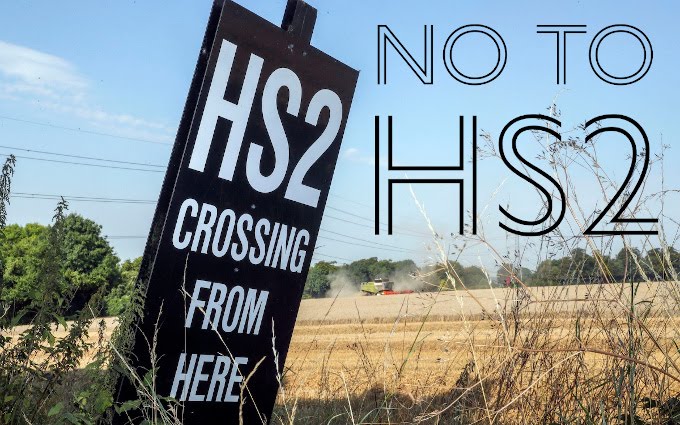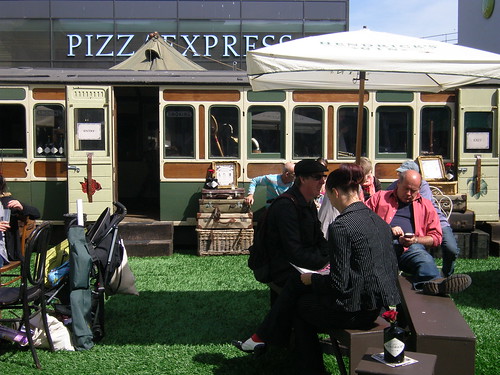This appears to be a Lancashire and Yorkshire Railway vehicle dating from around 1890. Now a mobile bar to promote a brand of gin under the name Hendrick's Horseless Carriage of Curiosities, seen here at the Brighton Festival.
25 May 2011
22 May 2011
Fares and rolling stock - the missed connection

The McNulty committee has produced a 350 page report on whether Britain's railways give value for money and how things might be improved. Proposed changes to fares have naturally received the most attention and comment, but there is an important chapter on rolling stock. The report refers to the lack of standardisation in rolling stock, with the result that some types of train are route-specific and cannot easily be redeployed.
This is noticeable south of London, where each of the three train operating companies now has a fleet which is incompatible with those used by the others. South Eastern and Southern both run Bombardier Electrostars but they have different couplings. South West Trains run Siemens and Alstom fleets which are mutually incompatible, as well as being incompatible with the Bombardier units. And all three train operating companies have trains inherited from British Rail which are incompatible with all the post-privatisation fleets.
This incompatibility should never have been allowed to develop but it seems that the rail franchising authorities were asleep when the critical decisions were being made.
It is in striking contrast to the situation on the same routes in the 1960s, when most of the fleet was standardised to the extent that all the EP types (such as the CIG class above) - everything built between about 1954 and 1974 - were operationally compatible. A train could be composed of stock belonging to any of the different EP classes. In addition, to provide even more flexibility, the class 33 diesel locomotives, the class 73 electro-diesel locomotives, and the REP high powered units could be used with any of the electric EP units, including the TC trailer sets which were specifically designed for push-pull operation.
This is over particular relevance to McNulty's analysis. It seems to have missed the connection between fares and rolling stock design. Recent decades have seen the near-universal replacement of locomotive-hauled stock with unit trains such as Voyagers and Pendolinos. Of fixed length, extra vehicles cannot be added to cater for extra traffic at peak periods. This must be a major reason for the complicated structure of fares which are meant to tailor a variable demand to a fixed supply in an attempt to get round the lack of flexibility.
Until about 1970, the railways had traditionally kept a pool of older vehicles in reserve, which would be brought out at peak periods, but modern methods of railway operation, and modern types of rolling stock rule out this option. It is a pity that McNulty failed to notice this.
20 May 2011
A brief thought
Discussion of railway matters is bedevilled on the one hand by lack of technical knowledge and on the other by a failure to understand that infrastructure gives rise to external value which turns up eventually in land values.
19 May 2011
Inter City 125 trains and the disability issue
In the article giving details of the IEP project, in the June issue of Today's Railway, one of the points made is that the Inter City 125 trains would have to be extensively reconstructed to make them compliant with the disability access regulations, and this is one reason why they need to be replaced soon.
This sounds like nonsense. A small build of DDR-compliant compatible vehicles would do the job perfectly well. With a life expectancy of 25 more years for the HSTs, the new DDR-compliant vehicles should outlast them, and by 2035 they will still have another 30 years or so to run, but it should not be difficult to find a use for this stock when the time comes.
This sounds like nonsense. A small build of DDR-compliant compatible vehicles would do the job perfectly well. With a life expectancy of 25 more years for the HSTs, the new DDR-compliant vehicles should outlast them, and by 2035 they will still have another 30 years or so to run, but it should not be difficult to find a use for this stock when the time comes.
IEP - A flawed concept
Details of the IEP project have been published in the June issue of Today's Railways. It does not look like a clever design.
The first point of criticism is that most of the units are hybrids and will be fitted with diesel engines, adding 16 tons to the weight of a 5-car unit, whilst being unused for most of the time, when they will be operating under the wires.
The second point of criticism is the length of the vehicles - 26 metres. Whilst this is a standard length on the Continent, it it too long for the UK, as the width then has to be reduced significantly to prevent excessive overhang on curves. Some work is being done on the infrastructure to reduce this overhang, but there must be better ways of spending the money. Passenger vehicles designed to run in the UK should not be more than 22 metres long so that they can be constructed to the full width of the available loading gauge.
With such long vehicles, to prevent having large gaps at stations with sharply curved platforms, the doorways have been moved well in from the vehicle ends, creating odd spaces which will be occupied by toilets, which is fine, and luggage space. That is not fine, because passengers cannot keep an eye on their property if it is far from where they are sitting, a situation which gives rise to anxiety every time the train stops at a station.
It is claimed that the stepping distance will be no worse than a mark 3 vehicle, but the stepping distances are one of the features of mark 3 stock where improvements are needed. In addition to being a hazard, awkward steps onto the train add to station dwell time as people have to be more careful when getting on and off.
Seating layouts are of course a matter for the operators to decide, but with rolling stock as expensive as the IEP, there is no alternative but to cram in as many seats as possible, which means that most of the seats are in an airline configuration. Although about one-third of passengers prefer this, and another third are indifferent, the problem with airline style seating is that it leads to a loss in the most desirable luggage space, between the seat backs where the owners can keep an eye on their things. Luggage space then has to be provided in special shelving, which also consumes seating space.
That the design has turned out like this it is no criticism of the engineers and designers involved. It is implicit in the concept of a hybrid train that can go everywhere without the need to change locomotives when it gets to the end of an electrified route. IEP is a good example of how a flawed concept has knock-on effects leading to a flawed design.
The first point of criticism is that most of the units are hybrids and will be fitted with diesel engines, adding 16 tons to the weight of a 5-car unit, whilst being unused for most of the time, when they will be operating under the wires.
The second point of criticism is the length of the vehicles - 26 metres. Whilst this is a standard length on the Continent, it it too long for the UK, as the width then has to be reduced significantly to prevent excessive overhang on curves. Some work is being done on the infrastructure to reduce this overhang, but there must be better ways of spending the money. Passenger vehicles designed to run in the UK should not be more than 22 metres long so that they can be constructed to the full width of the available loading gauge.
With such long vehicles, to prevent having large gaps at stations with sharply curved platforms, the doorways have been moved well in from the vehicle ends, creating odd spaces which will be occupied by toilets, which is fine, and luggage space. That is not fine, because passengers cannot keep an eye on their property if it is far from where they are sitting, a situation which gives rise to anxiety every time the train stops at a station.
It is claimed that the stepping distance will be no worse than a mark 3 vehicle, but the stepping distances are one of the features of mark 3 stock where improvements are needed. In addition to being a hazard, awkward steps onto the train add to station dwell time as people have to be more careful when getting on and off.
Seating layouts are of course a matter for the operators to decide, but with rolling stock as expensive as the IEP, there is no alternative but to cram in as many seats as possible, which means that most of the seats are in an airline configuration. Although about one-third of passengers prefer this, and another third are indifferent, the problem with airline style seating is that it leads to a loss in the most desirable luggage space, between the seat backs where the owners can keep an eye on their things. Luggage space then has to be provided in special shelving, which also consumes seating space.
That the design has turned out like this it is no criticism of the engineers and designers involved. It is implicit in the concept of a hybrid train that can go everywhere without the need to change locomotives when it gets to the end of an electrified route. IEP is a good example of how a flawed concept has knock-on effects leading to a flawed design.
16 May 2011
14 May 2011
Great Western franchise to be handed back early

FirstGroup is handing back its £1.1bn Great Western rail contract three years ahead of schedule after admitting that the deal, one of several £1bn-plus franchises struck at the height of the credit boom, had become unsustainable.
The company is exercising an option to terminate the franchise in March 2013 and avoid £826.6m in payments to the government due by 2016. It will join a new round of bidders over the next 18 months for a longer franchise to run trains from London Paddington to the west country, Wales and Oxford.
Read full article in Guardian here
The article refers to changed economic circumstances, but what seems to have been missed is that the Great Western route is going to be a headache for whoever runs it over the next few years, what with electrification, works associated with Crossrail, continuing disruption at Reading with the construction of a grade-separated junction in a built-up area with a high water table, and the introduction of fleets of new rolling stock to new designs - always a difficult time for operators having to maintain services whilst dealing with teething troubles.
Taking advantage of the provisions of the franchise, the decision to cut and run sounds like prudence. It could also pose a knotty problem for the future since FGW owns the fleet of HSTs (photograph) that operate on the route at present. If FGW is not awarded the franchise, where will the new incumbent get its trains from? So who else is going to bid for the franchise? Could First Group end up leasing and maintaining rolling stock for another train operating company? Or will no-one else even be interested?
Subscribe to:
Posts (Atom)

